There has been a lot of enthusiasm lately for the scientific side of bonsai. I’ve been a part of this, sharing stories, for example, of testing and acidifying water in an attempt to green up my garden.
I started pursuing the topic when I noticed how much harder it had become to keep my pines the deep green color that makes pines so appealing.
Looking for a technical solution, I sent a water sample to a lab and learned that the pH of my water was high. I’d tested it years before and found it to vary wildly throughout the year, but I had yet to see symptoms of water-related problems in the garden.
Now I was seeing increased signs of root pathogens and failing to keep my trees green even when I applied lots of fertilizer.
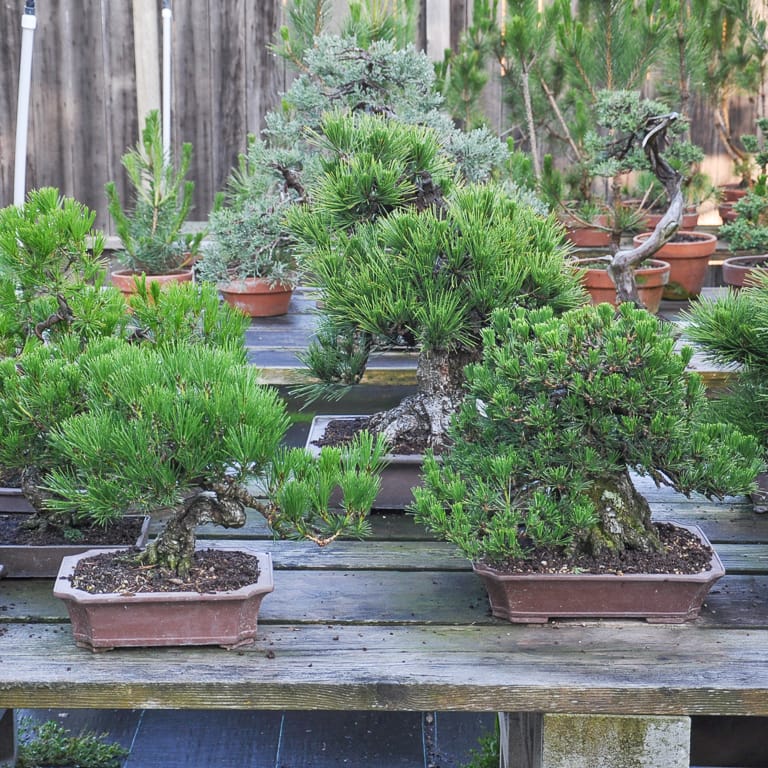
The good old days – black pines from my garden in 2009
Rewinding back to when I started growing bonsai, I had a small collection of odds and ends plus a small batch of black pines I’d grown from seed.
At the time, I didn’t know about tea bags or fertilizer baskets, and Japanese fertilizers weren’t easy to find. I opted for the least expensive organic product I could find – cottonseed meal – and simply spread it on the surface of the soil. I supplemented this with fish emulsion when I thought of it, but I didn’t follow a schedule and my applications were uneven.
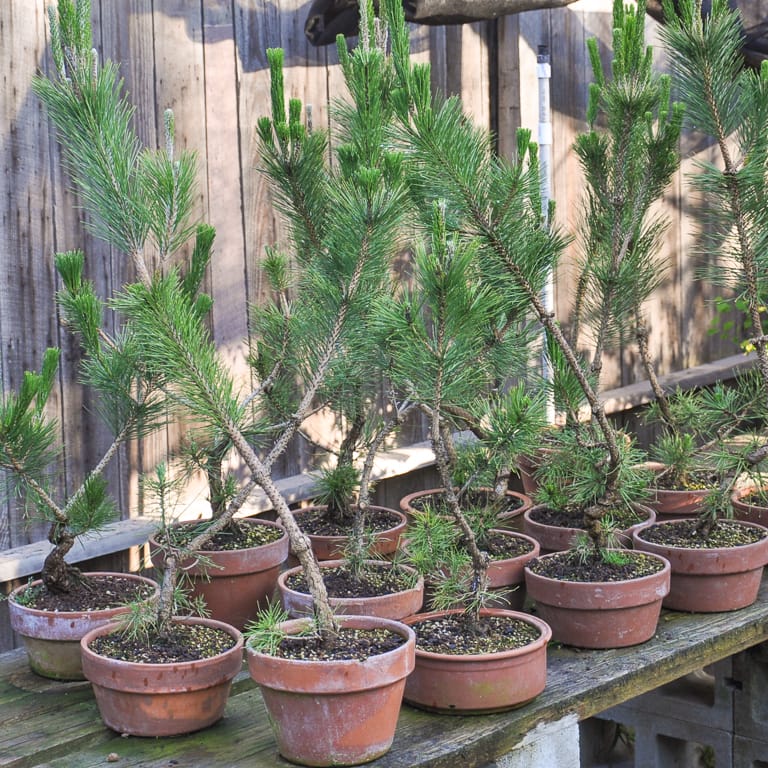
Young pines in 2009
These were also the years when I lived in an apartment and my trees were in a garden ten minutes away by bicycle. I worked at a job that prevented me from watering during the day so I installed an automatic system and didn’t check on the trees as often as I should have. As a result, the pines dried out a lot.
When I look back on these years, I now understand that applying cottonseed to the soil helped acidify the water, and reducing watering frequency is a great way to avoid root pathogens. In other words, I was taking an effective approach to keeping my trees healthy without realizing it.
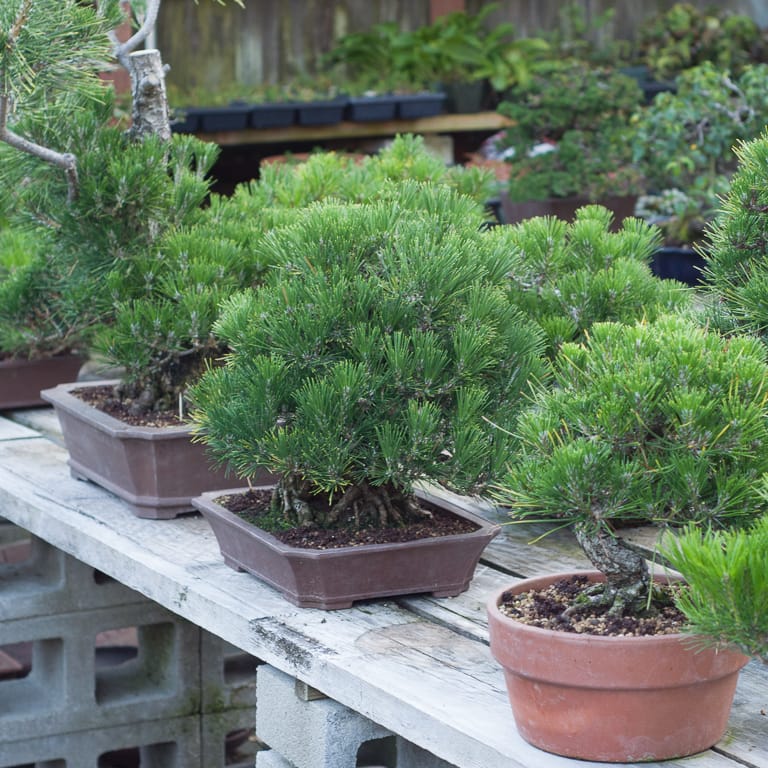
Green pines in 2012
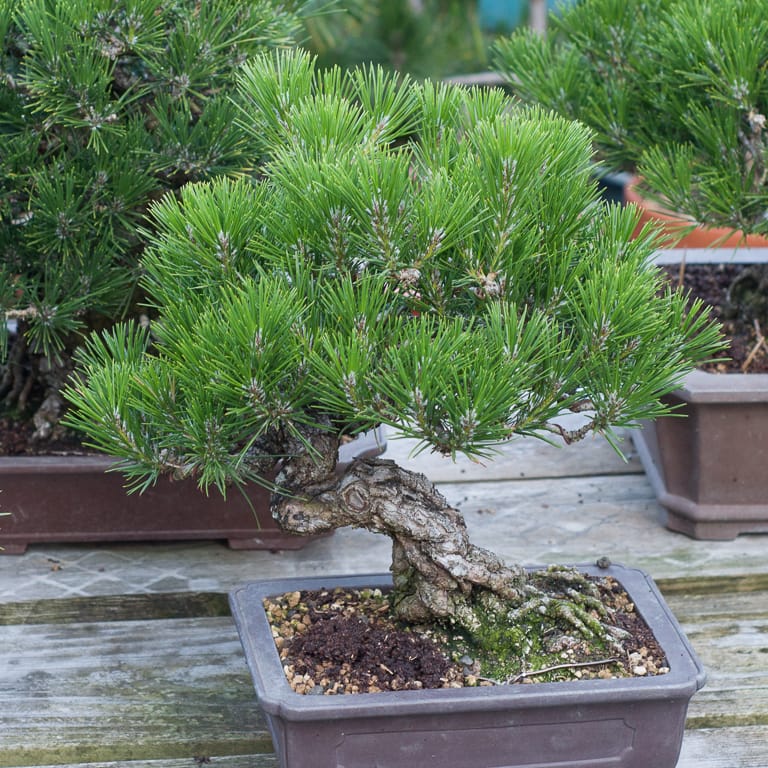
Cottonseed meal on the surface of the soil
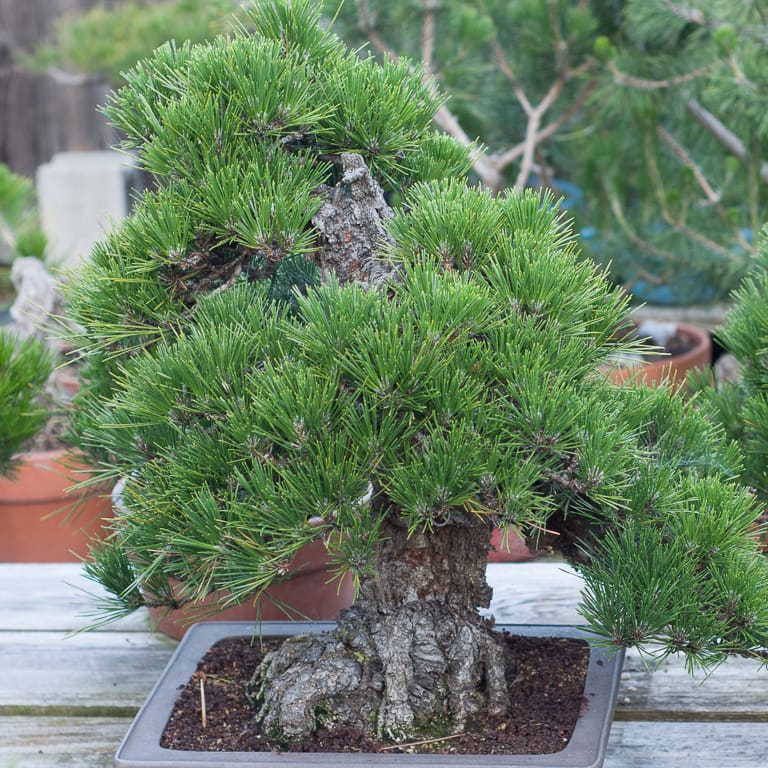
Cottonseed meal covering the soil surface
More recently, two things changed that led to my current problems. The first struck when I started doing bonsai full-time. Working from home allowed me to water more – which I thought was a good thing – and I likely stressed my pines by keeping them too wet.
A year or two later, I stopped using cottonseed meal and other dry fertilizers when I discovered the extent to which vermin had been stealing the tea bags and fertilizer baskets. I switched to using liquid fertilizers exclusively which meant I was only acidifying the water on days when I applied fertilizer. As a result, some days the trees got water in the pH 4 – 5 range, and the rest of the time it was over pH 9.0.
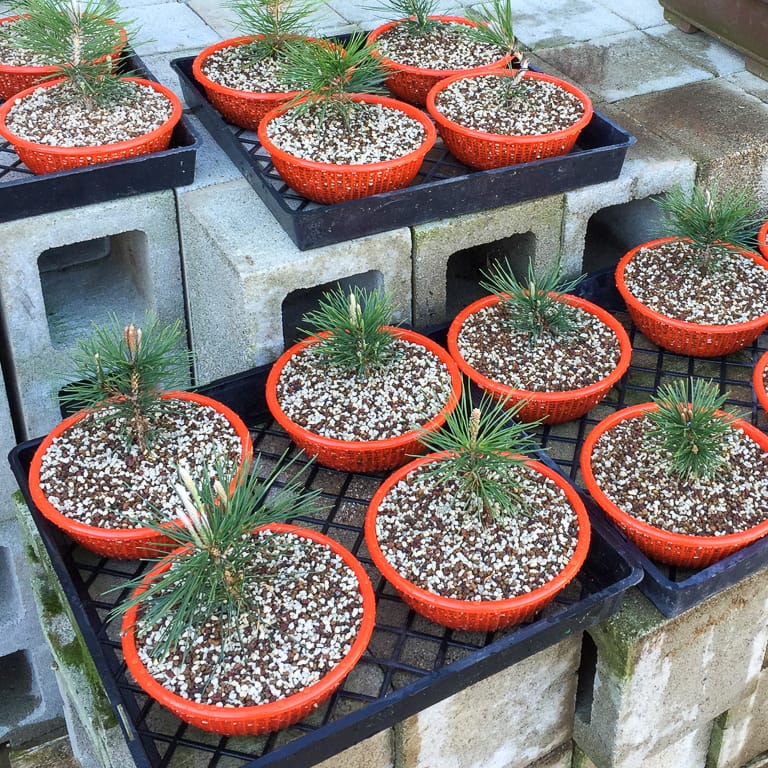
Dark green foliage on young pines in winter, 2015
I’m now working on the most effective way to keep my pines green in light of what I’ve learned over the years. I’m working with different fertilizers and soil amendments, adjusting watering frequency, and testing different locations in my garden.
The reason I wanted to share this story is that I don’t think every problem requires a scientific investigation, and that there are often plenty of solutions to problems that don’t require much time, money, or complexity.
At least that’s my goal. Will report back when I have more to share on the topic.
Introducing a new podcast – the Bonsai Wire!
In recent weeks, I’ve teamed up with Michael Hagedorn, Andrew Robson, and John Eads to start a new podcast. Our aim is to engage bonsai topics that interest us with interviews, Q&A episodes, and round table discussions.
Our first three episodes are available at bonsaiwirepodcast.com. They include an introductory episode, a round table discussion about collection management, and an interview with Colin Lewis.
More episodes are in the works so tune in and subscribe at:
bonsaiwirepodcast.com
Subscribe to Bonsai Tonight
New Posts Delivered Every Tuesday and Friday

James Stimmel says
Jonas,
After moving last Fall, I had to change the way I watered my trees. I use to catch the water from the air conditioner to water trees. At my new location, I am unable to repeat the process.
This past Spring, some pine seedlings sprouted in some of the pots. I dug up one and put it in its own pot. As we approached Summer, I noticed the seedling has lost its deep color and was a light green color. I purchased a water test kit from a pet store to test the ph of the water and found it was extremely alkaline. This can be adjusted by using vinegar. But, the only draw back is, you have to use a means of mixing, like a bucket of a drum.
Jonas Dupuich says
Hi James! Have you tested the water that comes out of the drainage holes when you water? The soil you’re using might affect the pH of the water. Sprinkling fertilizer on the surface of the soil can also help.
Ryan Huston says
Very interesting observations Jonas!
Jonas Dupuich says
Thanks, Ryan!
Carol Novak says
Why did you decide to modify fertilizing techniques to lower the pH of your soil rather than acidifying the water?
Jonas Dupuich says
In the past I used fertilizing techniques that modified the pH without knowing it. Today I’m looking at different fertilizers less for the benefit of acidifying and more because different trees in the garden have different fertilizing needs. It’s easy for me to run fish emulsion through a Dosatron for fertilizing the whole garden, but I have to water the garden twice now, once to water with acidified water, and once just for the trees that need fertilizer with the fish emulsion. Using dry fertilizers (that ideally don’t attract animals) can save a lot of time. I plan to continue using vinegar to acidify the water.
Erin Moyer says
Hi Jonas,
What model of Dosatron are you using? Previously you had mentioned using Dyna gro products. I wonder how often you use them and at what concentration? The type of nitrogen in the fertilizer has an impact on substrate pH over time as well. Have you explored this at all?
Jonas Dupuich says
Hi Erin – I use the Dosatron® D14MZ2 Injector. It’s one step up from the base model as the base model isn’t recommended for acidification.
As for the Dyna-Gro, the recommended concentration levels for injectors are included on the label which makes mixing concentrates easy. When it comes to how often it can be used, that’s more a matter of the overall fertilizing strategy for the garden.
I have yet to look at the impact on the soil pH over time. I don’t use a lot of Dyna-Gro – it’s a supplement to regular fertilizing with fish emulsion, also applied through the Dosatron – but it would be good to see if there are any longer-term effects on the soil. Will post on the topic if I find any significant changes in the soil.
Antonius G Nijhuis says
Hmm, interesting.
I have been using the same bonsai soil mix for the past 20 years. All the foliage on my trees are green. When I collect wild trees the foliage is slightly chloritic but after I heel them in they green up within 4 weeks. (organic material composted Doug Fir bark -fish composted )
Visitors, experts and tree buyers tell me I have been using the wrong mix for the last 20 years.
I have an organic component in the mix it buffers the ph it breaks down slightly but does decompose so pore space is not compromised. I do not use Akadama at all so I have been told that my mix is a no no. CEC is good bacteria in the soil water retention is good drainage is good root growth is good etc etc.
something to think about
I don’t worry about ph, fertilizer
Jonas Dupuich says
Hi Anton – great to hear from you! Using organic ingredients in the mix is a great way to lower pH and retain fertilizer. The biggest knock against it is that broken down organic material may not provide as good an environment for some trees over long periods of time. That said, 20 years in the same mix is great and there’s no reason to change it if it’s working!
Thanks for sharing!
Per Schultz says
I’d be very interested in knowing your recipe. If you’re willing to share it?
Michael M says
Hello Jonas,
I too had problems with critters taking my tea bag fertilizer. Mainly rats, mice and birds. I switched to an organic mix that was all vegetable ingredients. No fish meal, no bone meal, etc. This helped keep the tea bags on the pots.
Thanks
Michael
Per Schultz says
Very interesting Jonas!
What sort of soil amendments are you working with and what has been the results?
Thanks
Per
Jonas Dupuich says
Hi Per! I’ve been adding everything I have in the garden from iron-sulfur pellets to cottonseed meal to commercial fertilizers to black gypsum to see what makes a difference. I generally am testing several soils and fertilizers at any given time and as I learn a bit (usually about what not to do), I make notes and try another round. I don’t have interesting results from most experiments (for example, if I test 10 fertilizers, all 10 usually produce good results) but I’ll definitely share anything that isn’t obvious at a glance.
BTW, Anton has published a lot about how he cares for trees on his website – here’s a sample article on the topic: https://anijhuis.com/2013/08/12/my-methods-of-heeling-in-newly-collected-trees/
Terence Vaughn Krista says
Hi Jonas-
A very interesting post. The “correct” way to feed bonsai has always been a bit puzzling to me. You seldom read or hear of any organics being added to repotting mixes. I start with horticultural pumice but add some fir bark to acidify the mix. I always add some organic fertilizer as well, usually fish and kelp meal. It seems to provide a great boost to trees when they leaf out. I feed with fish emulsion throught the growing season. The business with cakes and teabags can seem overly tedious, and between the squirrels, mice, ants (raccoons even) can at times create more of a problem than solve one. Seems easiest and smartest to just put the fertilizer right into the soil mix.
Thanks for another interesting article.
Jonas Dupuich says
Thanks, Terence! It’s definitely easiest to put the fertilizer right into the mix, I just can’t say if it’s the best approach for long-term growing in a container (I don’t know one way or the other). What’d I’d love to see is evidence of someone who has used organics in the soil for twenty to forty-plus years on bonsai at a level similar to what we might see in a top Japanese exhibit. I’ve had mixed results in my garden with organics so I’m still in the testing phase.
Zack Clayton says
A lot of commentary on this post so here’s my 2 cents. I am a bit of a heretic. I use Turface as my primary aggregate. I know some people swear at it, but it works for me in my yard, which makes it the best soil for me. I also use off the shelf vegetable fertilizer in an even (eg. 10-10-10 or 10-14-12) ratio. I just make sure the nitrogen is lower than the phosporus or potassium. I sprinkle this on the soil surface around the first of the month. In between I’ll use Miracle Grow or similar in a dedicated 2 gallon sprayer after I water. If I want more nitrogen, I’l add a few tablespoons of ammonia to the water in the sprayer when I add the dry pellets for those trees. other than that, I hose water once a day.
Jonas Dupuich says
Thanks for sharing Zack! I’m not surprised your trees are healthy but am curious what you do when you want more refined growth, for instance, how you might feed an old deciduous bonsai with fine branching.
Mike Butler says
I have used organic based soils most of my bonsai time. Usually the first year after a repot is solid. The the soil breaks down and growth slows. I have started switching to an inorganic mix and the time for a turnaround is astounding. My yaupon hollies show great improvement in 2 weeks. Watering has not been nearly as difficult as I imagined, I overwater as well. I am closing in on 20 years.
Jonas Dupuich says
Thanks, Mike! I, too, am amazed at how fast trees can respond to fully inorganic mixes. That’s great your Yaupon hollies are doing so well – I plan to post about one next week.
Justin Everidge says
Hello Jonas. Long time no see.
I would say you should get an RO system for the garden. also look into some nematodes to help with soil problems and some Xtreme Gardening’s Azo and Mycoks, they will help with nutrient uptake. Test a couple of pines with these and see how it works. It will work I promise.
Jonas Dupuich says
Hi Justin! Thanks for the tips, it’d be fun to try the Azos and Mykos and see what difference they could make for common bonsai species. I’m testing some other mycorrhizae products now (no results as of yet) so I hope to find some patterns one way or the other.
I’ve used beneficial nematodes to combat root aphids and they appeared to help.
As for the RO, I’m fortunate in that I don’t have significant salts in the water so a very small amount of vinegar is all I need to get the pH down between 6 and 7.